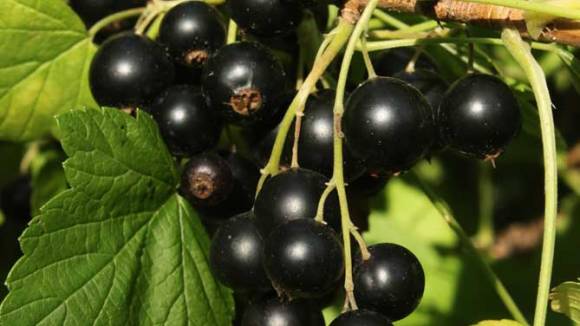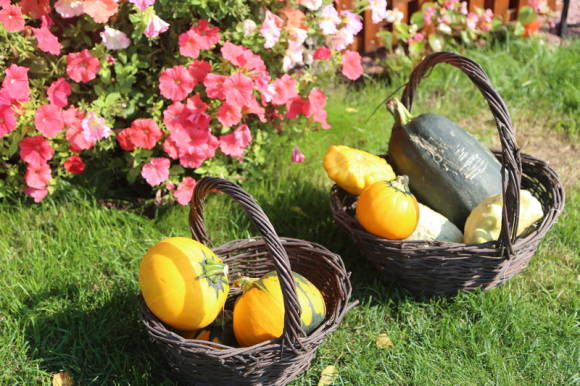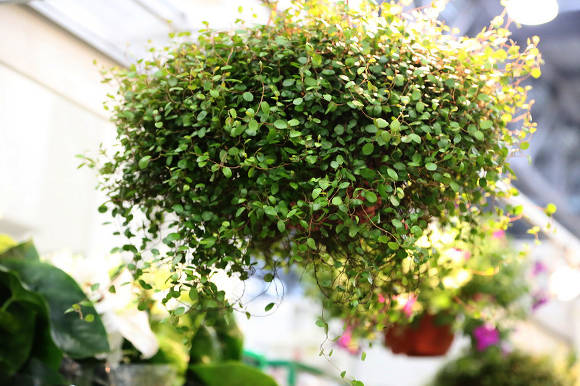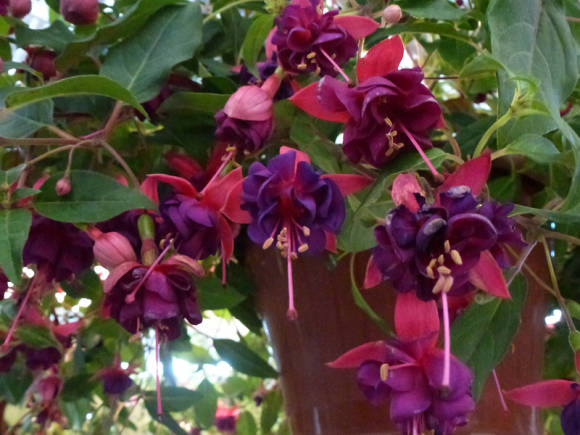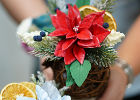Selenicereus golden-flowered, or Selenicereus Golden Heart (Selenicereus chrysocardium) - a very popular houseplant, although the species was discovered and described relatively recently. It was found in 1951 by Thomas Baillie MacDougall in the tropical rainforests of Mexico. And only after the first flowering in 1956 in a greenhouse, it was finally described by Edward Johnston Alexander and attributed to the genus Epiphyllum (Epiphyllum chrysocardium)... In 1959, Curt Backeberg was bred into the Marnier family (Marniera chrysocardium), but in 1991 this genus was eliminated, and on the basis of the fruits obtained by this time, it was attributed by Myron Kimnach to the Selenicereus genus. However, the systematic position of the species remains completely unclear and controversial; there is an opinion that it should be returned to the genus Epiphyllum.
 |
This plant leads an epiphytic lifestyle and is easily recognizable even in the absence of flowering. Climbing stems, branching, flat, up to 30 cm wide, deeply dissected almost to the central vein, which clearly protrudes. The plant can reach several meters in length and occupy a fairly wide area. The blades resemble leaves, up to 15 cm long, at the base up to 4 cm wide, with a sharp end. The epidermis is green, smooth, sometimes there is a reddish tint on young shoots. Areoles are small, sometimes with small 2-3 bristles, which later fall off. Aerial roots form on the stems, they cling to the trunks and branches of trees and help the plant to climb up.
The flowers are large, funnel-shaped, very fragrant, up to 35 cm long and 20-25 cm in diameter, open at night and close in the morning. The outer petals are creamy, with a reddish tint, 11-15 cm long and 8-10 mm wide, linear-lanceolate, sharp, wide open. The inner petals are white, 11-14 cm long and 2 cm wide, obverse-lanceolate, sharp. In the center are numerous bright yellow stamens, making the center of the flower appear golden. This gave the species name - chrysocardium, which translated from Latin means "heart of gold". Flowering occurs in winter, usually on the eve of Christmas and New Years.
For a long time it was not possible to obtain the fruits of this plant in greenhouse conditions, since all specimens existing in culture are most likely clones of one original plant, and when pollinated with their own pollen, seed setting and fruit ripening do not occur. Many forest cacti can be fertilized with pollen from closely related species and even genera (which is widely used to breed hybrid epicactus), but few of these plants bloom in winter. However, in 1981, Eckhard Meier, a renowned collector and creator of epicactus cultivars, managed to pollinate the spring Selenicereus Golden Heart flower with the pollen of another cactus. As a result, after 11 months, a 7-centimeter green fruit has ripened, completely covered with yellowish spines and resembling the fruit of Selenicereus Antonianus (Selenicereus anthonyanus), which was the reason to transfer this plant to the genus Selenicereus. Pollination with foreign pollen does not in any way affect the shape and color of fruits and seeds, they will be identical to fruits of natural origin, their external signs depend solely on the mother plant.
 |
This is truly a magnificent plant, its numerous, large carved stems are impressive, and flowering is just an unforgettable sight! But even without flowers, this is one of the most beautiful plants. Has a fast growth rate. Selenicereus Golden Heart shoots when grown at home can be let up the trellis, but it looks much more decorative in hanging baskets. It should be noted that this is a very large plant and it will achieve all its beauty, occupying a rather large space.But you can maintain it in a compact form, providing small pots for growth and shortening the length of the stems in time, and then, when the length of the shoots reaches at least 70-90 cm and under proper conditions, you can expect excellent winter flowering.
Selenicereus Golden Heart hybrids
Along with other forest cacti, Selenicereus Golden Heart can also be used to breed new varieties of Epicactus. So Eckhard Meier created a whole series of hybrid Epicactus under the general name Hunsrück (named after a mountain in Germany near Simmern's hometown).
When crossing a variety of epicactus, similar to "Moonlight Sonata", with Selenicerius chrysocardium Hunsruck Cub with large carmine flowers was obtained, Hunsruck Charm with large purple flowers, and Hunsruck Serenade with large flowers, the inner petals of which are lavender and the outer ones are purple.
Crossing of "Discovery" epicactus with Selenicereus chrysocardium large-flowered varieties were obtained: "Hunsruck Champion" with dark orange-carmine petals and "Hunsruck Citron" yellow.
Hybridization of the epicactus "Flammenspiel" and Selenicereus chrysocardium produced the following large-flowered varieties: "Hunsruck Feue" with shades of fiery orange and deep purple, "Hunsruck Rubin" with transitions from dark ruby to orange-red with purple throat, and "Hunsruck Silber" with silvery white inner and slightly yellowish outer petals.
Conditions of detention and care
Lighting bright, diffused. Direct summer sunlight can cause burns, but lack of light will cause deformed shoot growth and the plant may not bloom.
Priming loose, epiphytic, slightly acidic. Standard potting soil from flower shops for aroids or bromeliads is fine. About a third should be coarse material that drains well and prevents soil caking (small fragments of bark, perlite). To maintain the acidity of the substrate when watering with hard water, you can add sphagnum, high-moor peat to the land mixture, or acidify the irrigation water with lemon juice.
Watering... Water regularly and in moderation in summer, and keep the soil always slightly damp. Water with warm water after the top layer of the soil has dried, without waiting for the entire volume to dry out completely. Watering must be done from above, not from the pallet; be sure to remove excess water from the pallet after watering. Overdrying the coma has a detrimental effect on the condition of the roots, waterlogging or the choice of too heavy soil will lead to blockage of the capillaries, the air will not be able to approach the roots, which will cause their decay. In winter, it is necessary to reduce watering, but not bring it to complete drying out of the soil.
The air humidity is high, at temperatures above + 18 ° C, it is advisable to spray the stems several times a day, on hot days spraying is simply necessary.
Top dressing... It is necessary to apply universal fertilizer only from spring to autumn, in small doses.
Temperature... In summer, the optimum temperature is + 22 + 28 ° C. From autumn to spring, it is necessary to slightly lower the temperature of the content, to + 16 + 18 ° C. It is undesirable to allow temperatures below + 15 ° C. It is important to remember the heat-loving nature of this species, growing it together with other forest cacti, many of which endure cooling to + 5 + 7оС.
Bloom usually occurs in winter. To lay the buds, a period of relative dormancy is required in September-October, when the abundance and frequency of watering decreases and the temperature of the content decreases. A large drop in temperature (to low positive values) can lead to shedding of buds and damage to the plant. After flowering, there is another rest period until spring, when the coolness is also maintained and watering is reduced.
Diseases and pests... At home, it is possible to be affected by a mealybug and scabbard. If kept too cold, fungal diseases are possible. See the article Houseplant pests and control measures.
Reproduction
Reproduction is possible only vegetatively, by rooting stem cuttings. For this, fragments of stems of 10-15 cm are taken, the lower sections are powdered with dry Kornevin and the cuttings are immersed for several centimeters in a slightly moist soil of sand and ready-made peat soil (1: 1). Do not water the first 7-10 days, until the soil is completely dry, then water it very sparsely from the pallet so that only the bottom gets wet. Sparse and poor watering from the bottom will promote faster root growth and prevent cuttings from rotting. After about 3-4 weeks, rooting can be expected. From the moment the roots appear, start watering as usual from above.
If you are sure that you can provide the plant with the necessary conditions and space, then by all means get this beautiful plant!
Photo by the author
